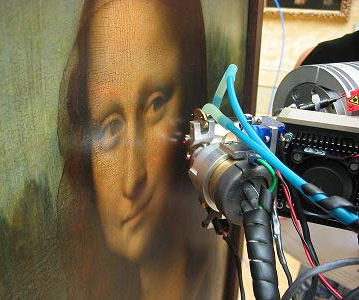Decode the faces in Leonardo Da Vinci's paintings
What materials did Leonardo Da Vinci use to create such vivid and perfect faces? For the first time, quantitative analysis was carried out on 7 paintings displayed at the Louvre Museum (including the Mona Lisa picture) without taking any samples from any picture.
The analytical results showed that the composition and thickness of each layer overlapped. In the painting, he used layers 1 to 2 microns thick. The study was conducted by Philippe Walter, a laboratory of the Center for French Museum Research and Restoration in collaboration with ESRF and the Louvre Museum, published in the Angewandte Chemie Journal.

Strange appeal of the paintings partly in the delicate combination of optical effects , blurring the contours, softening the transition color areas and playing subtle shadows like smog .
The technique of the famous artist is called ' sfumato ' which is not only the creation of the genius artist but also the technical innovations in the early 16th century. Meticulous investigation, optical measurement and reconstructed as the prototype Leonardo Da Vinci did, the researchers not only accurately described the sfumato technique, but also discovered the manipulations he had conducted, especially how to transfer colors through intermediate shades.
For the first time, Philippe Walter and his team shone new light rays into sfumato by applying chemical research methods to quantify different coatings . The seven paintings of Leonardo Da Vinci were directly analyzed right in the museum's gallery spaces without affecting the value of the work.
Scientists have focused on studying character traits in paintings, because they characterize sfumato drawing techniques. They used a method called ' X-ray fluorescence research ' to determine the composition and thickness of each layer of ultra-thin oil paint on nine faces Leonardo Da Vinci had painted during his 40 years of practice.
Scientists have also discovered the formula that Leonardo da Vinci densely blends colors to draw dark areas on the characters' faces. These recipes are characterized by an aging technique (using very thin coatings) and based on the chemical nature of pigments and additives. The artist has painted many thin layers of 1 to 2 microns overlapping each other to achieve a general thickness not exceeding 30 - 40 microns.
The research results help us understand how Leonardo Da Vinci spent a lot of effort to explore, create, make his extremely vivid and unique art.
- The culprit ruined Leonardo Da Vinci's self-portrait
- Decode the message hidden behind Leonardo da Vinci's Last Dinner
- The mystery of Leonardo Da Vinci's lost masterpiece
- Leonardo da Vinci: Anatomy scientist
- 5 extremely unknown secrets behind the paintings of genius Leonardo da Vinci
- Errors in the famous picture of Leonardo da Vinci
- The timeless designs of Leonardo da Vinci
- Find the lost masterpiece of Leonardo da Vinci?
- Leonardo da Vinci 'religion' buddy paintings?
- Find out the origin of the mysterious picture
- The true meaning of world famous paintings that most of us do not know
- Revealing the mystery of the 500-year mural of Leonardo da Vinci
 'Fine laughs' - Scary and painful torture in ancient times
'Fine laughs' - Scary and painful torture in ancient times The sequence of numbers 142857 of the Egyptian pyramids is known as the strangest number in the world - Why?
The sequence of numbers 142857 of the Egyptian pyramids is known as the strangest number in the world - Why? History of the iron
History of the iron What is alum?
What is alum?